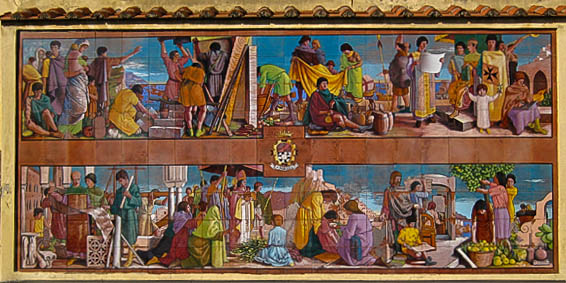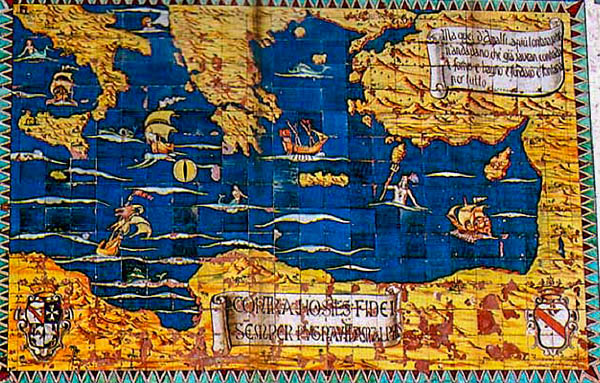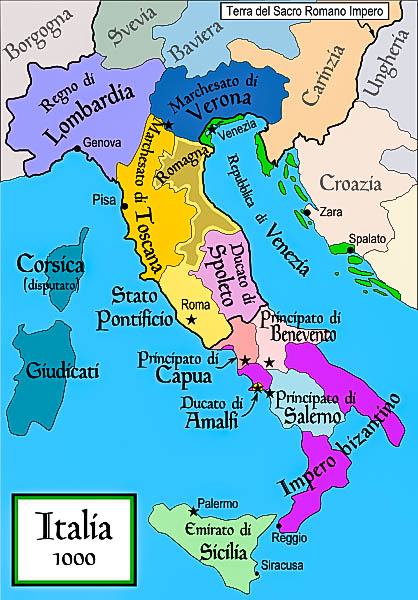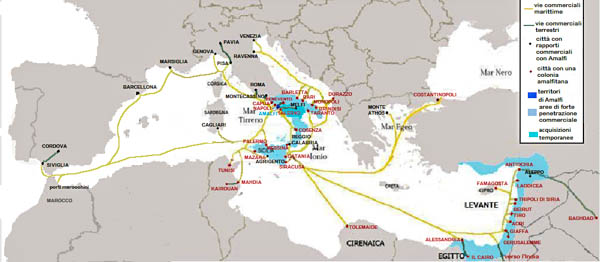- Places
- Plans
- Itineraries
- Experiences


Amalfi's first golden age was as an indepedent marritime city-state from AD 830 to 1135, during which it rivaled Venice, Genova, and Pisa as a Mediterranean trading power. By the 10th century, it was the seat of a Dukedom and minted its own coinage.
Amalfi's connections with the Orient stuffed its coffers with trade goods and made it the gateway to Europe for such Arab innovations as paper, coffee, carpets, and the compass—though Amalfi (all historical evidence to the contrary) still proudly claims they themselves invented that last one.
They've even erected a statue in the middle of the piazza at the port of hometown boy Flavio Gioia said to have fabricated the first compass in 1302. (This is patently untrue; Gioia might have popularized it, but the compass was undoubtedly an Arab invention, introduced to the West by Arab sailors—conceivably, yes, via the busy port of Amalfi. At best, Amafitani sailors were early adopoters of this revolutionary navigational aid.)

Amalfi again entered history when a local monk, backed by Amalfitani merchants, founded a hospital in Jerusalem along with a benevolent order that later became known as the Knights of Malta—today the only surviving order of knights from the Crusader age.
At its height, Amalfi had a population of 70,000, lorded it over the Thyrrhenian Sea, and was a European center for papermaking. Then the troubles began.
The Normans gave the town a whooping in 1131, and soon after Pisa swept in to trounce its rival. Twice. In 1135, Pisa sacked its defeated rival city-state, and it was all over.
Amalfi as an indepdendent city-state ended then, in 1135, but the real final blow came in 1343. A one-two combination of tidal waves and earthquakes slumped much of the proud, defeated Amalfi into the sea, erasing most of the city from existence and nearly obliterating the population.

Amalfi had nearly 70,000 inhabitants before the earthquake and tidal wave. It lost nearly 90 percent of its population in the catastrophe.
Ever since, Amalfi has struggled to maintain a population of around 6,000.
Amalfi limped along as a fishing port (with a sideline in that old art of papermaking) on an isolated but beautiful stretch of coastline. Curious grand tourists and German watercolorists occasionally popped in starting in the 19th century.
By the 1940s and 50s, the Jet Set had discovered the Amalfi Coast. Hollywood starlets and mid-century moguls flocked to Capri and the Amalfi Coast, soon to be followed by the sun-seeking masses, kicking off Amalfi's second, current golden age—that of tourism.
Planning your time: You could see every official "sight" in the town of Amalfi in 60–90 minutes—though it is a lovely place to relax for a while, maybe take a cappuccino on the piazza overlooking the steps up to the Duomo.
Amalfi also makes an ideal place to spend the night. It has several good restaurants, and the town is just large enough to keep the feeling that there's a bit of local life beyond the tourism, making it a joy to wander (the others—Positano and Ravello especially, may be more postcard-quaint and pretty, but Amalfi feels more real).
Besides, it is the one place on the Amalfi Coast where you have to switch buses—either to return west up the coast toward Postiano and Sorrento, to made a side trip up to pretty Ravello, or to continue east along the coast to Salerno.
Amalfi town is the turnstile for coastal public transportation. If you're traveling the Amalfi Coast by bus, you always have to get off in Amalfi at the main harborfront Piazza F. Gioia and switch to another bus to continue on, as this is the central terminus for buses from Sorrento and Positano to the west/north, Ravello up in the hills, and Vietri and Salerno to the east/south.
If you're driving, there's public parking lot by the port.
Share this page
Search ReidsItaly.com